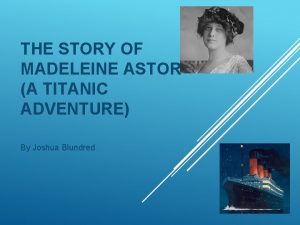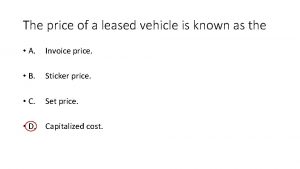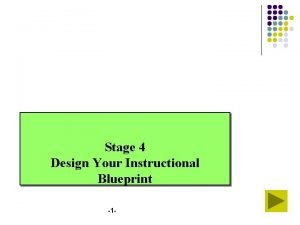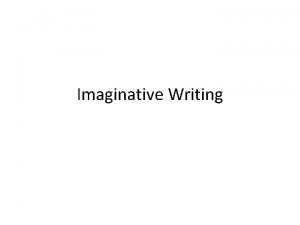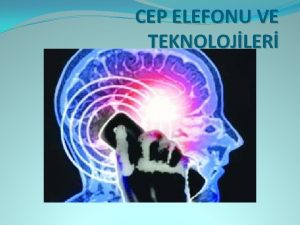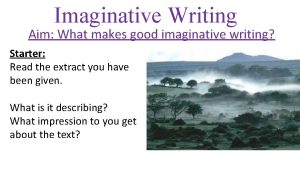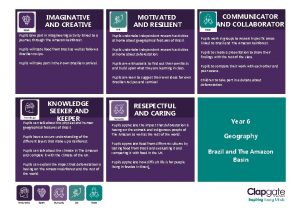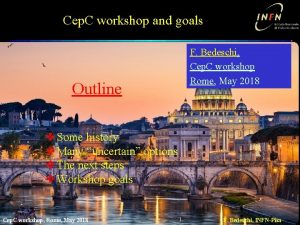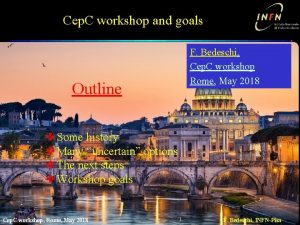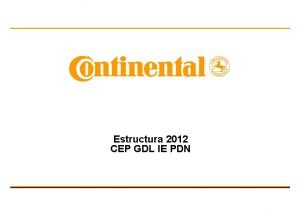Imaginative Ian Madeline Ensign CEP 802 Final Design












- Slides: 12

Imaginative Ian Madeline Ensign CEP 802 Final Design Project

Ian – Motivational Summary �Ian is a bright, kind, social, and imaginative four year old preschooler in a GSRP funded preschool in an urban area. �He is a natural leader and well liked by all of his peers. �He has impressive language and vocabulary skills. �Ian loves to play. He often requests to skip teacher directed activities so he can play. �During teacher directed activities, Ian often pouts and has a difficult time participating.

Motivational Assessment � The Setting - Ian’s classroom is a typical preschool classroom. It is warm and inviting and decorated with the children’s artwork. It includes all the different interest areas, such as blocks, art, sensory, etc. It has a great variety of toys and activities all located at the level of the child. The children have access to everything they need while in the classroom. There are two adults and 15 children. � Ian is often distracted by all the toys in the room and often just wants to play. � Preconditions - All of Ian’s basic needs are met while he is at school. The two teachers have great relationships with Ian. When Ian is struggling to join the group, he often gets one on one support from an adult. The lessons are also often modified so they are always done at his level. During free choice time, children are able to make a choice in the activity they complete.

Pre –Intervention TARGET Approach � Task – The children have little say in the activities that they are completing at the beginning of the year. This is to allow us to introduce them to different things in the room and allow us to introduce rules and regulations. � Authority – Children do not have a say in how the activity is learned at the beginning of the year. � Recognition – Recognition is given, publicly and privately, to every student based on progress, not the finished product. Effective praise is used. � Grouping – Children work in small groups that are selected and directed by the teacher. � Evaluation – There are no grades, only assessments. Assessments only assess their skills, each child has a set of personalized goals. � Time – Children are given the time they need to complete each task.

Key Ideas from Assessment �Ian only wants to play and does not have much of an interest in teacher directed activity. �Ian shows more of an interest in the activity when he feels like he is playing or the activity is hands on. He also shows an interest when he can make a choice. �He states that he is bored, does not have much experience with teacher directed activities. �He is a bright child and he is showing a lot of progress despite his lack of motivation during teaching time.

Lack of Motivation and the Course Ideas � Ian is not allowed to choose his own activities, so, like most, he lacks motivation. “(Intrinsic motivation) concepts apply best when people are feely engaging in self-chosen activities, usually play or recreational activities rather than work or learning activities. ” (Wentzel and Brophy, 81) � Ian is not interested because he cannot choose what he is learning about. “You can induce your students to generate their own motivation to learn by asking them to think about topics or activities in relation to their own interests or preconceptions. ” (Wentzel and Brophy, 90, 2014)

Rationale and Goals �Even though Ian has aspects of school that he enjoys, I would love to see him participate in teacher directed work time even when it is a task he finds ‘boring. ’ �He is such a bright child, and I would like to see him develop his intrinsic motivation for this year and beyond. �Allowing Ian to choose his own activities and lessons will increase his intrinsic motivation.

Motivational Strategies � I believe that Ian’s motivational struggles stem from a lack of experience with structured activities and a general lack of interest in most teacher directed academic activity. � The best thing to help motivate him is to continue to develop the relationship between Ian and his teachers. � I would like to incorporate Ian’s interests in teacher directed times. � Giving meaningful praise will be beneficial; however, that is not my main focus. � Hopefully his intrinsic motivation will increase and he will now be more interested in learning things with a more academic focus.

New TARGET Strategies � The TARGET strategies that have been modified were task, authority, and group work. � One strategy that I have incorporated is allowing Ian to help develop the task and have some authority over it. There is a lot of freedom in Creative Curriculum. Teachers teach to the children’s interests while incorporating different activities to help children learn and meet important milestones. � Ian has been able to help choose theme that he learns about depending on his and his classmate’s interests. � Group work was also slightly altered. More hands on activities were incorporated for Ian because he seemed to be more engaged with those activities.

Results �I have seen great progress with Ian. �Altering my lessons to allow Ian to use hands on materials that he is interested in has increased his intrinsic motivation. �Allowing him to help choose themes and ask his own questions has increased his intrinsic motivation. �Ian now is more willing to participate in teacher directed small and large groups even when he did not have any choice in the activity. �He still occasionally gets moody, but his attitude and attention span are developmentally appropriate.

Next Steps �To help Ian keep up with his new found intrinsic motivation, I will continue to build my relationship with him and learn about his interests. �I will continue to modify lessons to fit his interests when it is feasible, and I will continue to take the class’s interests into account while we are theme planning. �I will continue to give Ian effective praise as his efforts continue to improve.

References �Stipek, D. (2002). Motivation to learn: Integrating theory and practice (4 th ed. ). Boston: Allyn and Bacon. �Wentzel, K. , & Brophy, J. (2014). Motivating students to learn (Fourth ed. ). New York, NY: Routledge.
 Bridges from 802.x to 802.y
Bridges from 802.x to 802.y Bridges from 802.x to 802.y
Bridges from 802.x to 802.y Josephine ensign
Josephine ensign Did madeleine astor survive the titanic
Did madeleine astor survive the titanic Madeline adeane
Madeline adeane Madeleine leininger teori
Madeleine leininger teori Madeline moore summer camp grant
Madeline moore summer camp grant Price of a leased vehicle is known as the
Price of a leased vehicle is known as the Makalah teori keperawatan madeleine leininger
Makalah teori keperawatan madeleine leininger Concept of teaching
Concept of teaching Madeleine leininger transcultural nursing theory
Madeleine leininger transcultural nursing theory Madeline morcelle
Madeline morcelle Taiiku no hi
Taiiku no hi



